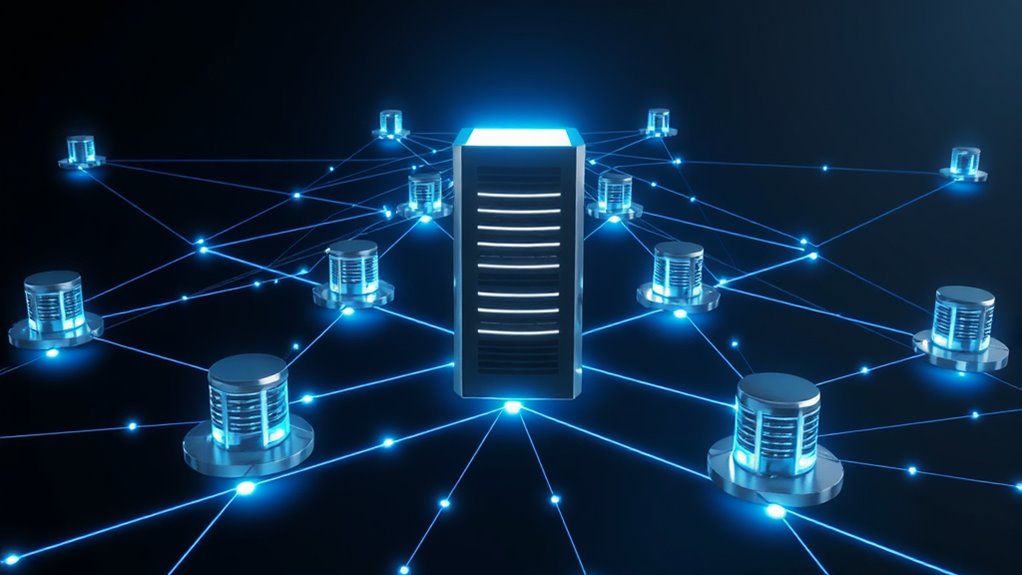API integration enables applications to communicate and exchange data through standardized protocols and interfaces. Modern applications utilize APIs to connect different software systems, automate workflows, and enhance functionality through third-party services. This integration requires key components like client applications, server processing, and secure authentication mechanisms to protect data transfer. API management tools and platforms streamline these connections while maintaining security and performance. Understanding these foundational elements reveals the broader scope of modern application architecture.

As modern applications become increasingly interconnected, API integration has emerged as a cornerstone of efficient software development and business operations. API integration enables seamless communication between different software applications, allowing them to exchange data and automate workflows without manual intervention. This functionality is achieved through well-defined protocols like REST, SOAP, GraphQL, and Webhooks, each serving specific integration needs and use cases. Third-party APIs occasionally experience downtime that can impact application performance. API management practices enhance integration efforts by improving documentation and security measures.
The process of API integration involves several key components working in harmony. A client application initiates requests to access specific services or data, while a server application processes these requests and returns appropriate responses. Between these endpoints, API middleware handles the essential task of data translation and formatting, ensuring compatibility between systems. Business efficiency increases significantly when manual processes are replaced with automated API integrations.
Authentication mechanisms, such as API keys, OAuth, and JWT tokens, secure these interactions and protect sensitive information from unauthorized access.
Modern businesses leverage API integration to enhance their applications’ capabilities rapidly. Instead of building features from scratch, organizations can integrate third-party services, accelerating time-to-market and reducing development costs. This approach also enables the creation of microservices architectures, where independent components communicate effectively through APIs, promoting scalability and maintainability.
Integration platforms and tools have evolved to support these complex requirements. iPaaS solutions provide unified interfaces for managing API integrations across distributed environments, offering prebuilt connectors and templates that minimize custom coding needs. These platforms support both synchronous and asynchronous communication patterns, ensuring ideal performance and reliability in various scenarios.
Security remains paramount in API integration implementations. Organizations must implement robust authentication methods, maintain proper API gateway configurations, and regularly monitor API calls to prevent data breaches.
The complexity of modern distributed systems demands sophisticated security measures, particularly when handling sensitive data or maintaining compliance requirements. Through careful implementation of these security practices and utilization of appropriate integration tools, organizations can create efficient, secure, and scalable application ecosystems that drive business value and innovation.
Frequently Asked Questions
What Security Measures Protect APIS From Unauthorized Access and Potential Breaches?
APIs are protected through multiple security layers including authentication protocols like OAuth 2.0 and JWT tokens, which verify user identity.
HTTPS encryption safeguards data transmission, while rate limiting prevents abuse through request restrictions.
API gateways monitor traffic and enforce access controls, while role-based permissions restrict endpoint access.
Regular security assessments and input validation help identify vulnerabilities, and sensitive data is encrypted both in transit and at rest.
How Do Version Control Systems Handle API Updates Without Disrupting Existing Integrations?
Version control systems manage API updates through strategic branching and versioning policies. They maintain separate development branches for new versions while preserving stable production branches.
Key features include:
- Semantic versioning to track breaking changes
- Automated testing for backward compatibility
- Feature toggles to control new functionality
- Detailed documentation and changelogs
- Gradual deprecation of old versions with migration guides
This approach allows organizations to roll out updates systematically while existing integrations continue functioning uninterrupted.
What Are the Typical Costs Associated With Implementing and Maintaining API Integration?
API integration costs fall into two main categories: initial development and ongoing maintenance.
Basic integrations typically range from $2,000-$6,000, while complex enterprise solutions can exceed $30,000.
Annual maintenance costs run between $50,000-$150,000, covering engineering support, security updates, and troubleshooting.
A team of eight specialists, including developers and architects, is usually required for thorough API management.
These costs vary based on integration complexity and documentation quality.
Can Legacy Systems Be Effectively Integrated With Modern APIS?
Legacy systems can be effectively integrated with modern APIs through strategic approaches and proper tooling.
Integration methods include:
- Using middleware solutions to bridge legacy protocols with modern standards
- Implementing API gateways for secure communication
- Exposing legacy functionalities through REST or SOAP APIs
- Utilizing database connectors when native APIs aren’t available
Success depends on careful planning, thorough compatibility assessment, and selecting appropriate integration methods based on the legacy system’s architecture.
How Do API Rate Limits Affect Application Performance and Scalability?
API rate limits considerably impact application performance and scalability by controlling request traffic flow. They prevent system overload by restricting the number of calls within specific time windows.
While rate limits protect backend stability, they can create challenges like increased latency and potential timeouts.
Different rate limiting strategies, such as token bucket and leaky bucket algorithms, help balance performance needs with system protection.
Effective implementation requires proper error handling and monitoring.









